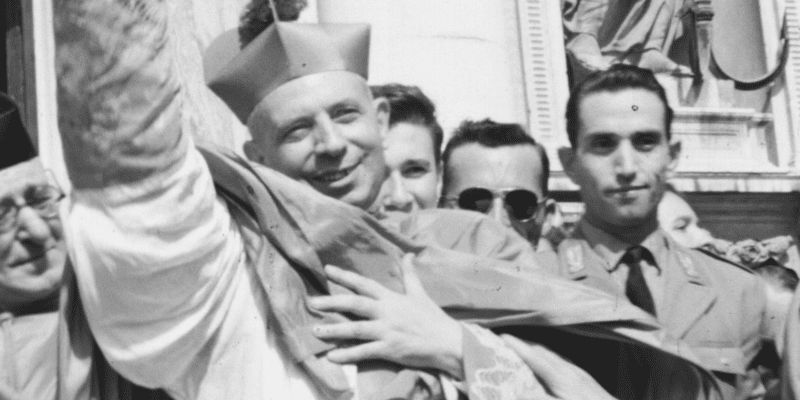ROME – Because Pope Francis so often cites both the substance and the spirit of Vatican II as an inspiration for his papacy, there’s a tendency to assume he’s sort of the Latin American reincarnation of St. John XXIII, the pope who convened the council and who was canonized by Francis in 2014.
In reality, however, one could make the argument that the Vatican II figure to whom Francis is closest actually isn’t John XXIII but rather Cardinal Giacomo Lercaro of Bologna, Italy, the council’s leading apostle of the “option for the poor.”
This very day, Lercaro’s vision is staging a comeback during the Oct. 6-27 Synod of Bishops on the Amazon.
During a Mass held early this morning, a group of bishops taking part in the synod signed onto the “Pact of the Catacombs,” an agreement originally inked by 42 bishops who were members of Vatican II in 1965. The name refers to the fact that the signing took place after a Mass in the Catacombs of Domitilla about 5 miles to the south of St. Peter’s Square, in order to symbolize that the Church was at its finest when its was stripped of all earthly vanities.
Basically, the agreement amounted to a manifesto for a poor Church on the side of the poor.
The original 42 bishops who signed that day in 1965, and the more than 500 who eventually added their names, pledged to “try to live according to the ordinary manner of our people in all that concerns housing, food, [and] means of transport…. We renounce forever the appearance and the substance of wealth, especially in clothing … and symbols made of precious metals.”
The architect of the agreement was Archbishop Hélder Câmara of Olinda and Recife in Brazil, who would go on to become the episcopal godfather of the liberation theology movement in Latin America. Its inspiration, however, was Lercaro, who had electrified the council with a 1962 address in which he insisted that poverty, and the Church’s option for the poor, ought to be the organizing principle of the entire summit.
Bishop Luigi Bettazzi was an auxiliary bishop under Lercaro in Bologna in 1965 when he signed the Pact of the Catacombs, signifying his mentor’s support. At 95, today Bettazzi is the only original signatory still living.
Students of the history of Vatican II will tell you that in the post-concilar years, the council became framed largely in terms of intra-church debates between liberals who wanted ever greater reforms on doctrine, liturgy, sexual morality and the like, and conservatives who feared those reforms were going too far.
In fact, Lercaro always represented a third option for the “spirit of Vatican II,” one focused less on inside ecclesiastical baseball and more on the Church as a tribune for the poor and downtrodden of the world.
That vision didn’t really cut much ice in the era of the Cold War, when many Catholic leaders worried it sounded too much like taking sides with the Communists against the capitalist West, but it did seep into Latin America, where it mutated into many forms – not only the liberation theology of Dom Hélder but also Argentina’s teología del pueblo, which influenced a young Jesuit priest by the name of Jorge Mario Bergoglio.
It’s no accident that Lercaro and his option for the poor developed in Bologna, which in Italy has long been known as Bologna Rossa for its strong presence of the Communist party. Although Lercaro was both an ardent anti-fascist and anti-Communist as a young man, as archbishop he launched a dialogue with members of the Italian Communist Party and attempted to reconcile the Church with the country’s political left, largely on the basis of the social gospel and a shared passion for the poor.
The option for the poor wasn’t just talk for Lercaro, by the way. In his early years in Bologna he converted the palatial archbishop’s residence into an orphanage for indigent children, earning plaudits from the city but raised eyebrows from some of his fellow churchmen. He was considered a papabile, or candidate to be pope, when John XXIII died in 1963, but was considered simply too idiosyncratic for some of his fellow Princes of the Church.
Lercaro resigned in 1968, in part because of a homily he delivered on Jan. 1 of that year for the Church’s first World Day of Peace in which he expressly criticized America’s bombings of Vietnam. The homily reflected the thinking of Lercaro’s friend and advisor Father Giuseppe Dossetti, a former anti-fascist and member of the Christian Democrats who’d served both in the Italian parliament and on Bologna’s city council.
In his farewell message, Lercaro said: “The pope told me to come, and I came. Now the pope tells me to go, and I go.” It was his way of getting across that he was quitting under pressure, as Pope Paul VI, now St. Paul VI, had concluded that Lercaro was simply a bridge too far for a Catholic Church struggling to maintain unity in the late 1960s.
Lercaro’s spirit nevertheless lived on in a variety of ways, among other things in the “Bologna School” of Italian Church historians Giuseppe Alberigo and Alberto Melloni and their famed history of Vatican II.
Perhaps his greatest legacy, however, was the Pact of the Catacombs and the path not taken for the Church immediately after Vatican II which it suggested. The current Synod on the Amazon thus demonstrates that sometimes, under the right circumstances and leadership, a road less traveled can turn into a superhighway.
Follow John Allen on Twitter: @JohnLAllenJr
Crux is dedicated to smart, wired and independent reporting on the Vatican and worldwide Catholic Church. That kind of reporting doesn’t come cheap, and we need your support. You can help Crux by giving a small amount monthly, or with a onetime gift. Please remember, Crux is a for-profit organization, so contributions are not tax-deductible.














